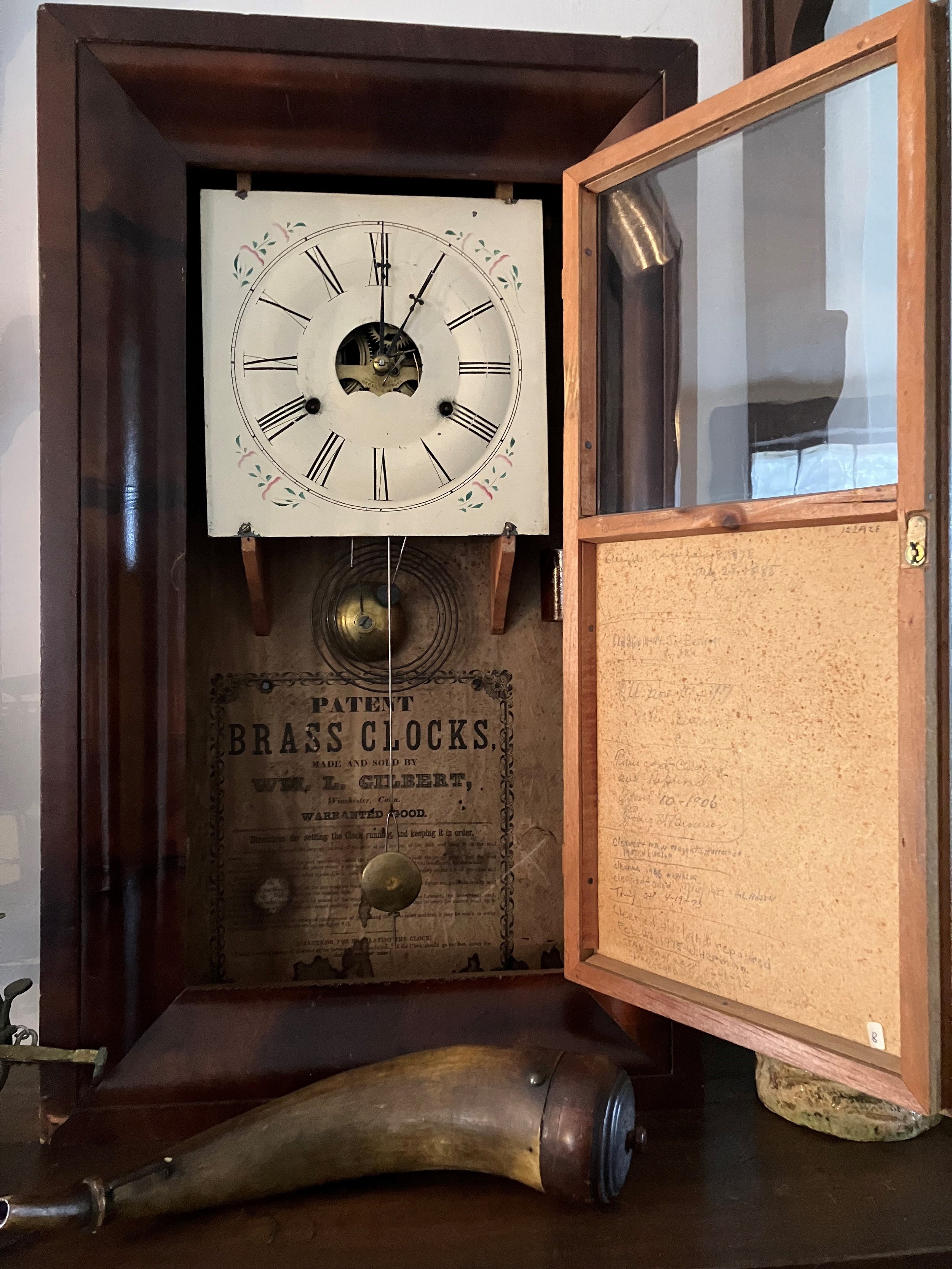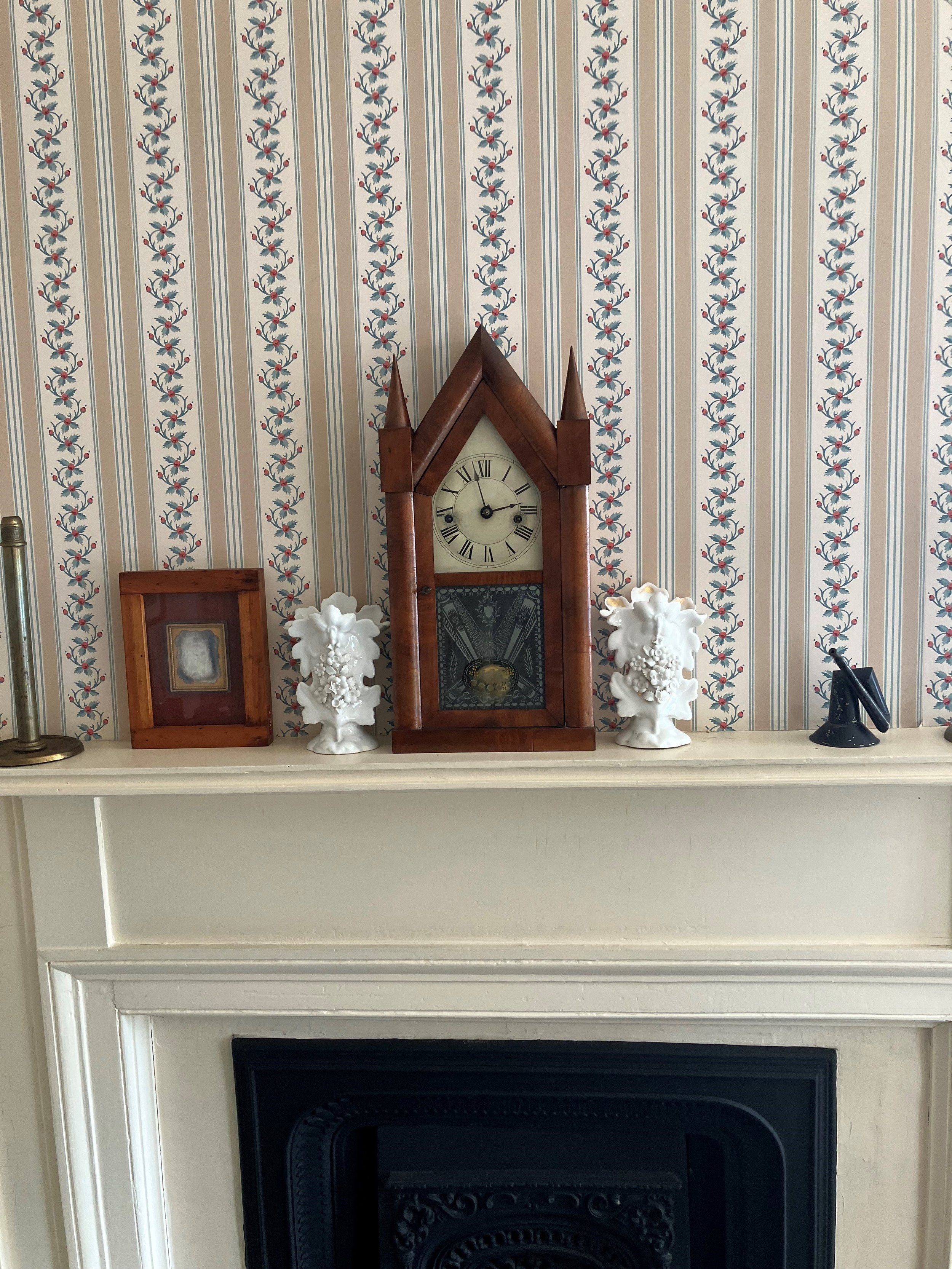Keeping Time
The Clocks of Dunham Tavern
Duncan Virostko, Museum Assistant
“Come what come may, Time and the hour runs through the roughest day.”~ Macbeth, Act One, Scene Three; William Shakesphere, 1606
One of the many projects here at Dunham Tavern happening in our bicentennial year is the restoration of its clocks. The chiming of the hour of these ancient time keepers truly helps to make a building feel lived in, rather than a mere museum specimen. In our current age of silent digital hour keeping, we have forgotten the importance not only of keeping time but also of the sonic and visual impact that mechanical clocks had on a 19th century household.
The relationship between 19th century people and time was a far more intimate one than our present period. It would have been a day to day task for the Dunhams to wind their clocks and watches, check and synchronize the time between them, and ensure that none were running slow. In the period before railroads, clocks followed local times: the timezone was a necessary invention for the railroad to keep schedules as trains could travel across entire time zones in a matter of hours. In the period of the Stagecoach and Canal, when Dunham Tavern served travelers, every town would have kept their own time, based on the local conditions of noon. This made telling time particularly difficult for travelers, and the only thing that kept them from running afoul of this multiplicity of times was the sheer slowness of travel. When going from Cleveland to Buffalo took the better part of a few days, for example, the precise time of one’s arrival was unimportant. It was only the advent of the railroads, and the need for precise scheduling to prevent collisions between trains, that time zones began to emerge.
“Shield” or “Wag on the Wall” Clock, Pennsylvania Dutch, ca. early 1800s
Dunham Tavern is blessed with a wealth of clocks spanning the breath of the 19th century in terms of period and form. The earliest clock on display is the “Wag on the Wall” clock. This style is so called because its pendulum is fully exposed and “wags” on the wall like the tail of a dog. These clocks were popular in the 18th century, but declined in popularity in the 19th century. Our particular example is a typical “Shield” type, which was originally located in a Pennsylvania Dutch farmhouse. When it is restored, and returns to display, it will be placed in the front hallway of Dunham Tavern, its painted pineapple motif on the dial complementing the pineapples in the stenciling. As clocks evolved in public perception from miraculous to mundane, as so many products do, fashions changed and the more exposed form of the “Wag on the Wall” style clocks were seen as gauche.
Consumers wished to see less of the internal workings of clocks, and so the classical “Grandfather clock”, also sometimes called “Tall Case Clocks” emerged as the dominant early 19th century style clock. Dunham Tavern has three Grandfather clocks in its collection: two located downstairs in the Parlor & Dining Room respectively, and one at the top of the stairs to the second floor.
Tall Case-Shield Hybrid Clock, Gift of Oriana Stephens, ca. early 1800s.
The Grandfather clock in the Dining Room represents an interesting half-step in the evolution of clocks and reminds us also of the hardships faced by early Ohio settlers. It is, in essence, merely a Wag on the Wall clock stuffed into a case. The clock mechanism sits in a one piece case, hanging from a nail inside it in the manner of a wall clock. This type of clock was actually quite popular with early settlers: it allowed for a complex and expensive clock mechanism to be purchased separately from the Eastern states, and brought to Ohio in a more compact form. Upon their arrival in the new Ohio country, a local furniture maker could then be employed to build a case for the clock in the latest style. The local furniture maker, however, was no clockmaker. The case for such a clock is somewhat ungainly, and does not make maintaining the mechanism, which can usually be done by removing the “hood” on top of the case, tricky. The structural integrity of merely hanging a clock in a cupboard is also somewhat suspect. Interestingly, records indicate this clock was gifted to the museum in 1946, upon the death of Mrs. Oriana Stephens, the last owner of Dunham Tavern before it became a museum.
Lumen Watson Tall Case Clock, Cincinnati, Ohio, Ca. 1816
The clock in the Parlor, on the other hand, is by far the most historically significant and complex timepiece at Dunham Tavern. Although it has suffered some damage to its face in its journey through time, this clock is still proudly emblazoned with the legend “L. Watson, Cincinnati”. The clock itself is circa 1816, and is the work of Lumen Watson, a well known early American, Ohio-based clockmaker. His chief claim to fame, aside from undoubtedly being one of the first clockmakers in Ohio, is that most of his early tall case clocks feature a movement made entirely of wood. This may seem strange, but is easily explained by two important historical facts. First, it was prohibitively expensive at the time to import brass clock parts from the eastern states to Ohio, due to the poor state of transportation in the first decade of the 1800’s. Second, at the time the United States was facing a national shortage of brass. The large copper reserves of the Upper Peninsula of Michigan had yet to be discovered, and mining these deposits would not start until after it had become a state in 1837. Whereas Lumen Watson was maker of the clock movements, he delegated the task of creating the cases to other craftsmen. In the case of our clock, this was Ephriam Davis. Another one of Lumen Watson’s assistants, Hiram Powers, was just 17 when he joined the company in 1822. However, he would later go on to become one of the most well known sculptors in the early United States. (Powers’ work The Greek Slave, was one of the first fully nude female sculptures in the classical style to be produced and exhibited in the United States, in 1843.)
The Lumen Watson clock is significant not only for its wood mechanism, but also for its complexity. Unlike all other clocks in the museum, it features a second hand, which is located on a small, separate dial above the hour and minute hands. Below this, there is another dial and hand, an aptly named “complication” which tracks the days of the month as well. This not only makes it the most accurate clock in our collection in terms of its ability to measure time, but also suggests a changing relationship with time that the 19th century brought. No longer would measuring hours and half hours do: business, and the Industrial Revolution, demanded split-second precision! Until the mid-20th century, clockmakers would be chasing ever more accurate clock movements, with more and more complications available for rich owners in ever smaller packages. True accuracy would ultimately be achieved by discarding weight and even spring-driven mechanisms, and developing at first crystal-based movements and later the atomic and digital clocks.
The remaining clocks in Dunham’s collection are all mantel clocks, a smaller and more compact form of clock which became popular after 1820. They represent an evolution of the form of clocks from a functional looking machine for telling time like Wag-On-The-Wall clocks, to miniaturized and inconspicuous piece of decor.
Brass Works Ogee Clock, William L Gilbert & Company, Bristol, Connecticut, ca 1865
In the beginning, the evolution of the clock into something inconspicuous began with the Ogee clock, a style named after the molding profile that made up its case. This shape was intended to restrain the weights of the clock, which were originally conical, from swinging about in the case as it was being moved: a hint towards the more urban, and mobile society of the 19th century, which might be expected to move house more frequently and take their clocks with them. This particular clock has an entirely brass movement, and was made by the William L Gilbert & Company, of Bristol, Connecticut, and has been ticking out the hours since sometime between 1865 and 1867, the earliest service date noted on the inside of its door. Its current display location is reflective of its later period, as archaeological and documentary evidence confirm that the north wing of the tavern, where the keeping room is, was constructed ca. 1853.
Terry & Andrews Co. Steeple Clock, Bristol, Connecticut, ca 1840
Another style of clock, a gorgeous mahogany veneered “Steeple” clock made by the Terry & Andrews Co. in Bristol, Connecticut, in the 1840s, is located on the second floor in Rufus & Jane Dunham’s Room. It has an all brass mechanism, and is spring driven vs our other, weight driven clocks. One of the pointiest objects in our collection, this style of clock evokes the ornate Gothic cathedrals of Europe in form, while still being elegantly simple in decoration. It features an entirely brass movement, and is representative of the sort of clock brought in by retailers from the Eastern states as first the Ohio & Erie Canal, and later the railroads ended the early Ohio clock making industry, and revolutionized commerce and transportation for the state. Theodore Terry and Franklin Andrews were the founders of this firm, which began making clocks in 1843. In 1850 they moved to Ansonia, Connecticut, the factory town of brass miller Anson Phelps, who became their third business partner. The company later went on to become the Ansonia Clock Co., which would produce thousands of clocks until its bankruptcy in 1929 amidst the Great Depression. A decorative glass panel, with an etched ornate design framing a painting of a pair of white doves, completes the clock’s decoration and is typical of mantle clocks of the period. Such fragile, thin glass on occasion did not always survive the ravages of time: the other mantle clock located in the Keeping Room shows evidence of this as it’s original flat, clear glass panel was replaced by a beveled, mirrored one during one of the numerous repairs and servicings the stenciling of dates on the inside of it’s door attest to. The artistry, however, does not end on the surface. Beneath the face, its mechanism’s frame hides a secret. It is shaped in the ornate form of an ancient lyre, an impressive display of craftsmanship on the part of the clock maker. Thanks to Gunter Schwegler’s recent restoration work on the clock, we are now able to share a picture of its long hidden secret below.
“Lyre” Brass Movement, Terry & Andrews Co. Steeple Clock, Bristol, Connecticut, ca 1840
Sadly, this clock is no longer able to strike the hour. In the 19th century, it was typical to build clocks with an extra spring power, to make them run slightly more than the one day advertised running time. This was typically something like 30 hours, in total… but Terry & Andrews endowed this particular clock with the power to run something more like 48! The result has been that the soft brass of the striking gear, powered by the same spring as the rest of the clock, has had its teeth completely stripped and was irreparable. The time gear is in a half worn state, so it is estimated that in perhaps another hundred years, both gears will have to be completely replaced. Nonetheless, the clock still happily runs along keeping time just as well as it did when it first left the factory. Perhaps, in this humble clock, then, we can see something of ourselves, and our own legacies.







